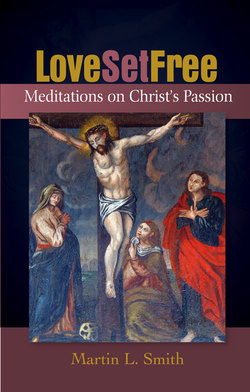Читать книгу Love Set Free - Martin L. Smith - Страница 9
На сайте Литреса книга снята с продажи.
ОглавлениеJohn 19.1–16a
Then Pilate took Jesus and had him flogged. And the soldiers wove a crown of thorns and put it on his head, and they dressed him in a purple robe. They kept coming up to him, saying, ‘Hail, King of the Jews!’ and striking him on the face. Pilate went out again and said to them, ‘Look, I am bringing him out to you to let you know that I find no case against him.’ So Jesus came out, wearing the crown of thorns and the purple robe. Pilate said to them, ‘Here is the man!’ When the chief priests and the police saw him, they shouted, ‘Crucify him! Crucify him!’ Pilate said to them, ‘Take him yourselves and crucify him; I find no case against him.’ The Jews answered him, ‘We have a law, and according to that law he ought to die because he has claimed to be the Son of God.’
Now when Pilate heard this, he was more afraid than ever. He entered his headquarters again and asked Jesus, ‘Where are you from?’ But Jesus gave him no answer. Pilate therefore said to him, ‘Do you refuse to speak to me? Do you not know that I have power to release you, and power to crucify you?’ Jesus answered him, ‘You would have no power over me unless it had been given you from above; therefore the one who handed me over to you is guilty of a greater sin.’ From then on Pilate tried to release him, but the Jews cried out, ‘If you release this man, you are no friend of the emperor. Everyone who claims to be a king sets himself against the emperor.’
When Pilate heard these words, he brought Jesus outside and sat on the judge’s bench at the place called The Stone Pavement, or in Hebrew Gabbatha. Now it was the day of Preparation for the Passover; and it was about noon. He said to the Jews, ‘Here is your King!’ They cried out, ‘Away with him! Away with him! Crucify him!’ Pilate asked them, ‘Shall I crucify your King?’ The chief priests answered, ‘We have no king but the emperor.’ Then he handed him over to them to be crucified.
The Gospel of John is the only one that identifies an eyewitness source for the narrative of Jesus’ passion. The narrator could have revealed the identity of his source at the beginning of the story, but he waits until a particular moment to reveal that it is the disciple whom Jesus loved, the man who dared to keep company with the mother of Jesus at the foot of the cross, who speaks to us. John tells us, ‘He who saw this has testified so that you also may believe. His testimony is true, and he knows that he tells the truth’ (19.35). This moment of identification comes after Jesus’ death on the cross, as soon as his body is pierced by the soldier’s spear, letting forth a stream of blood and water.
This image of penetration from outside to the inmost place of Jesus’ own heart is a mysterious sign of the character of the fourth Gospel. This Gospel penetrates the surface of the events of Jesus’ life, death and resurrection to reach into the hidden depths, the insideness of it all.
The story of Jesus’ passion can be told as a drama, a passion play, whose impact comes from the way it seizes our imaginations and stirs up our feelings through the unfolding of vivid scene after vivid scene. Lurid details can draw us into the events as spellbound spectators. But John’s Gospel is not an invitation to undergo the pathos and catharsis of a dramatic spectacle like the famous passion play of Oberammergau, with its wrenching re-enactment of the crucifixion. Instead, it is an invitation to surrender ourselves to a movement into the hidden depths of it all.
